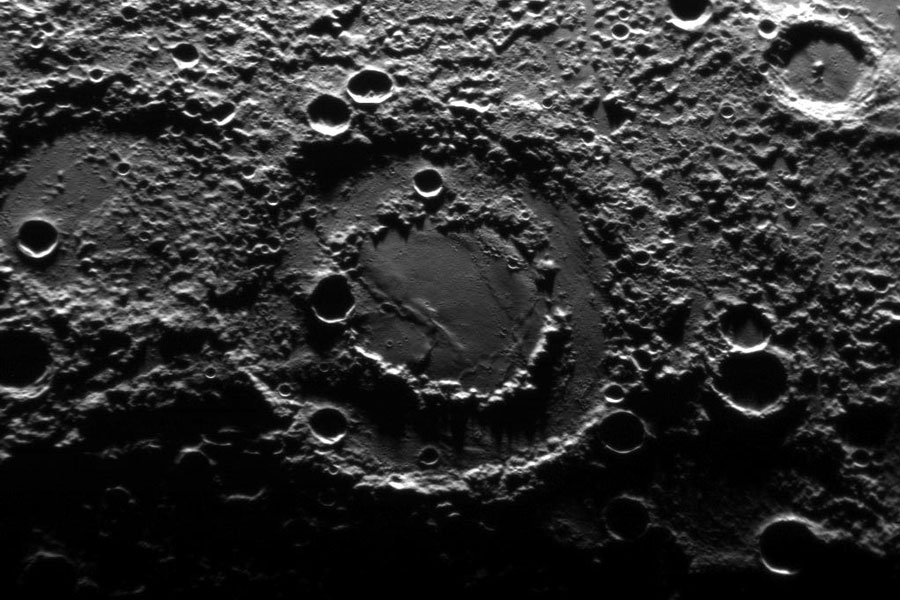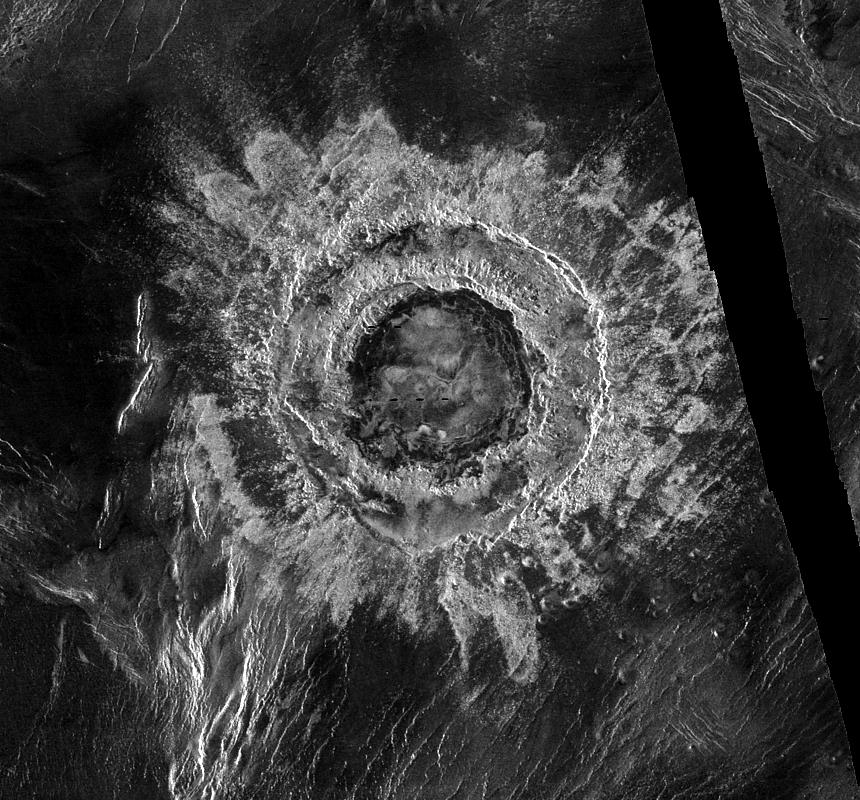S
silylene
Guest
APOD today had this interesting article about a curious double ringed crater on Mercury. Large double ring craters are not uncommon on planets and moons, and are thought to be caused by rebound effects, slumping and volcanism. However, this one is curious...
The blurb below dismisses the idea that a second impact could occur right in the center of the first impact. But I think it is possible to have a double impact in one spot, near simultaneous, and I have been waiting for evidence of it. I think we should've discovered about one such event by now somewhere in the solar system.
Here is why: we know that quite a few asteroids are doubles or have close-in moonlets. It's rather common in fact (~2-5% total, IIRC). My hypothesis is this: if a double asteroid hit Mercury and the alignment happened to be just right so that the companion asteroid was in a trailing position at the moment of impact, then what would happen is the second strike would be in the center of the first strike. Statistically, a close asteroid pair would be in an aligned formation for a double strike in one spot (aligned within +- 10 degrees of straight in) about 2*2*10/360 * 100% = 11% of the time [assuming that the double asteroid co-rotation plane is congruent the ecliptic plane....if no tendency for the asteroid doublet to be congruent with the ecliptic plane, then double strike in the same spot would be about 1.2% of collisions]. So chances are I think that we should see at least one example of a near simultaneous double strike in one spot somewhere within the solar system. Maybe this is one? If so, I'd expect a rougher surface in the region between the inner and outer ring, as also observed.
http://antwrp.gsfc.nasa.gov/apod/astropix.html
Explanation: What created the internal second ring of this double ringed basin on Mercury? No one is sure. The unusual feature spans 160 kilometers and was imaged during the robotic MESSENGER spacecraft's swing past our Solar System's innermost planet last week. Double and multiple ringed basins, although rare, have also been imaged in years past on Mars, Venus, Earth, and Earth's Moon. Mercury itself has several doubles, including huge Caloris basin, Rembrandt basin, and enigmatic Raditladi basin. Most large circular features on planets and moons are caused initially by a forceful impact by a single asteroid or comet fragment. Since it is unlikely that a second impact would occur right in the center of the first, large double rings are usually attributed to a subsequent volcanic lava flow inside the impact crater. Possibly, though, a second ring could be caused by the melting and flowing of material upon impact. One clue to the origin of the above-imaged double ring is that the basin center appears much smoother than the region between the rings. MESSENGER has now completed its last flyby of Mercury but will return and attempt to enter orbit in 2011 March.

The blurb below dismisses the idea that a second impact could occur right in the center of the first impact. But I think it is possible to have a double impact in one spot, near simultaneous, and I have been waiting for evidence of it. I think we should've discovered about one such event by now somewhere in the solar system.
Here is why: we know that quite a few asteroids are doubles or have close-in moonlets. It's rather common in fact (~2-5% total, IIRC). My hypothesis is this: if a double asteroid hit Mercury and the alignment happened to be just right so that the companion asteroid was in a trailing position at the moment of impact, then what would happen is the second strike would be in the center of the first strike. Statistically, a close asteroid pair would be in an aligned formation for a double strike in one spot (aligned within +- 10 degrees of straight in) about 2*2*10/360 * 100% = 11% of the time [assuming that the double asteroid co-rotation plane is congruent the ecliptic plane....if no tendency for the asteroid doublet to be congruent with the ecliptic plane, then double strike in the same spot would be about 1.2% of collisions]. So chances are I think that we should see at least one example of a near simultaneous double strike in one spot somewhere within the solar system. Maybe this is one? If so, I'd expect a rougher surface in the region between the inner and outer ring, as also observed.
http://antwrp.gsfc.nasa.gov/apod/astropix.html
Explanation: What created the internal second ring of this double ringed basin on Mercury? No one is sure. The unusual feature spans 160 kilometers and was imaged during the robotic MESSENGER spacecraft's swing past our Solar System's innermost planet last week. Double and multiple ringed basins, although rare, have also been imaged in years past on Mars, Venus, Earth, and Earth's Moon. Mercury itself has several doubles, including huge Caloris basin, Rembrandt basin, and enigmatic Raditladi basin. Most large circular features on planets and moons are caused initially by a forceful impact by a single asteroid or comet fragment. Since it is unlikely that a second impact would occur right in the center of the first, large double rings are usually attributed to a subsequent volcanic lava flow inside the impact crater. Possibly, though, a second ring could be caused by the melting and flowing of material upon impact. One clue to the origin of the above-imaged double ring is that the basin center appears much smoother than the region between the rings. MESSENGER has now completed its last flyby of Mercury but will return and attempt to enter orbit in 2011 March.




